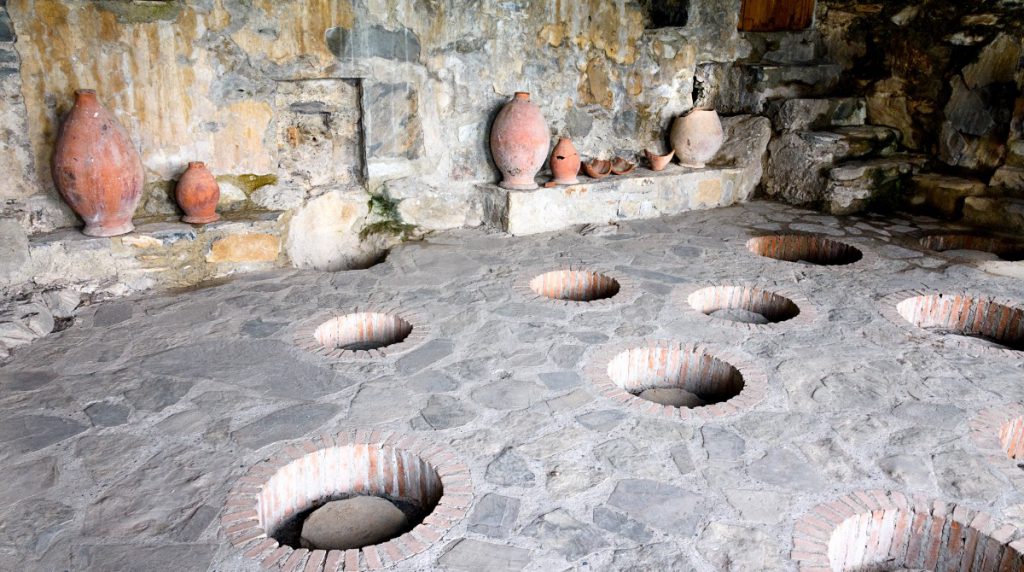The use of the amphora in winemaking dates back some 6,000 years. However, only recently has this ancient technique been rediscovered in the world of wine, especially natural wine.
In this article, xtraWine will introduce you to what amphora vinification entails and how it is used today.
Before starting, let’s discover a little historical background on the origin of amphora winemaking!
xtraWine curiosity corner: the origin of amphora winemaking
In Georgia, at two archaeological sites in Shulaveri Gora and Gadachrili Gora, located close to the Georgian capital Tbilisi, fragments of amphorae dating back some 6,000 years were discovered in which traces of malic acid, citric acid and succinic acid were found.
Manufacturers of amphorae suitable for winemaking today are in Georgia, Spain and Italy. However, Georgia is the only country where amphorae for winemaking have never stopped being made. It is best known for using traditional ovoid-shaped wineskins made of baked clay called Qvevri.
As a result, the use of Qvevri has spread so widely in the country that it has become a proper winemaking method. So much so that in 2013 UNESCO included the Qvevri method in the Intangible Heritage of Humanity list.
The Qvevri method
Qvevri is the name of a particular earthenware vessel used for winemaking. The Qvevri has a capacity of between 100 and 4,000 litres (average capacity of 1,000 litres). These amphorae do not have handles and are intended for burial. They are made of earthenware and are not glazed.
The amphorae are covered with a thin layer of beeswax inside to limit evaporation and exchange with the outside environment. On the other hand, the outside is covered with lime. The amphorae are buried in hidden rooms, ensuring a constant temperature during the fermentation and maturation phases and the ageing step.

Winemaking in Qvevri
The Qvevri method involves several solutions regarding the use of skins and marc:
- Firstly, “Imereti” involves using about 10% skins and grape seeds without stalks.
- Secondly, “Kartli” involves using about 30% skins, grape seeds and stems.
- Finally, “Kakheto” (also used by Joško Gravner) involves using the must from the marc, complete with skins, seeds and stems.
After a soft pressing, the must is put into Qvevri. Hence the method is unique, and the timing is decisive.
In fact, during the first 10 days or so, alcoholic fermentation occurs, which starts thanks to indigenous yeasts spontaneously.
During this short time, the Qvevri is left open for:
- Release carbon dioxide from the vessel.
- Allow the grape marc cap to be pushed to the bottom, favouring the extraction of polyphenols and other components in the marc.
Nature regulates temperature: buried amphorae can maintain a relatively low temperature. Once fermentation is complete, the marc settles to the bottom in small quantities due to the unique shape of the Qvevri.
The amphorae are then filled to the brim with more wine of the same type.
A lid is then placed over the opening until malolactic fermentation is complete.
The vinification in amphora today
Italy and Spain
In Spain, the centre of amphora (Tinajas in Spanish) production is Villarrobledo, which has been active in this field since the 17th century.
In Italy, the first specialised company is Fornace Artenova, located in Impruneta (Florence, Tuscany), producing jars since 2008. The peculiarity of these Italian amphorae is the terracotta from Impruneta, which does not require an inner coating of beeswax because it does not disperse the wine. Furthermore, these amphorae do not release metal substances, according to analyses.
Joško Gravner
In 1996, Joško Gravner, the undisputed Italian forerunner of vinification in amphora, did his first experiment in the vinification of Ribolla wine with extended maceration on the skins.
“I am convinced that wine is a product of nature, not man, whose role is to accompany its maturation process, avoiding any artificial intervention”.
This conviction of Joško Gravner is a bit of the core of the biodynamic system.
The production of wines from organic and biodynamic agriculture is, in fact, on the rise, as is the demand from a commercial point of view in Italy and other countries.
We believe that winemaking in these amphorae can soon be experimented with by all wine producers who will convert to organic or biodynamic production either partially or entirely. So, lots of traditions but also a new path for organic wines. Try all of them on xtraWine!









